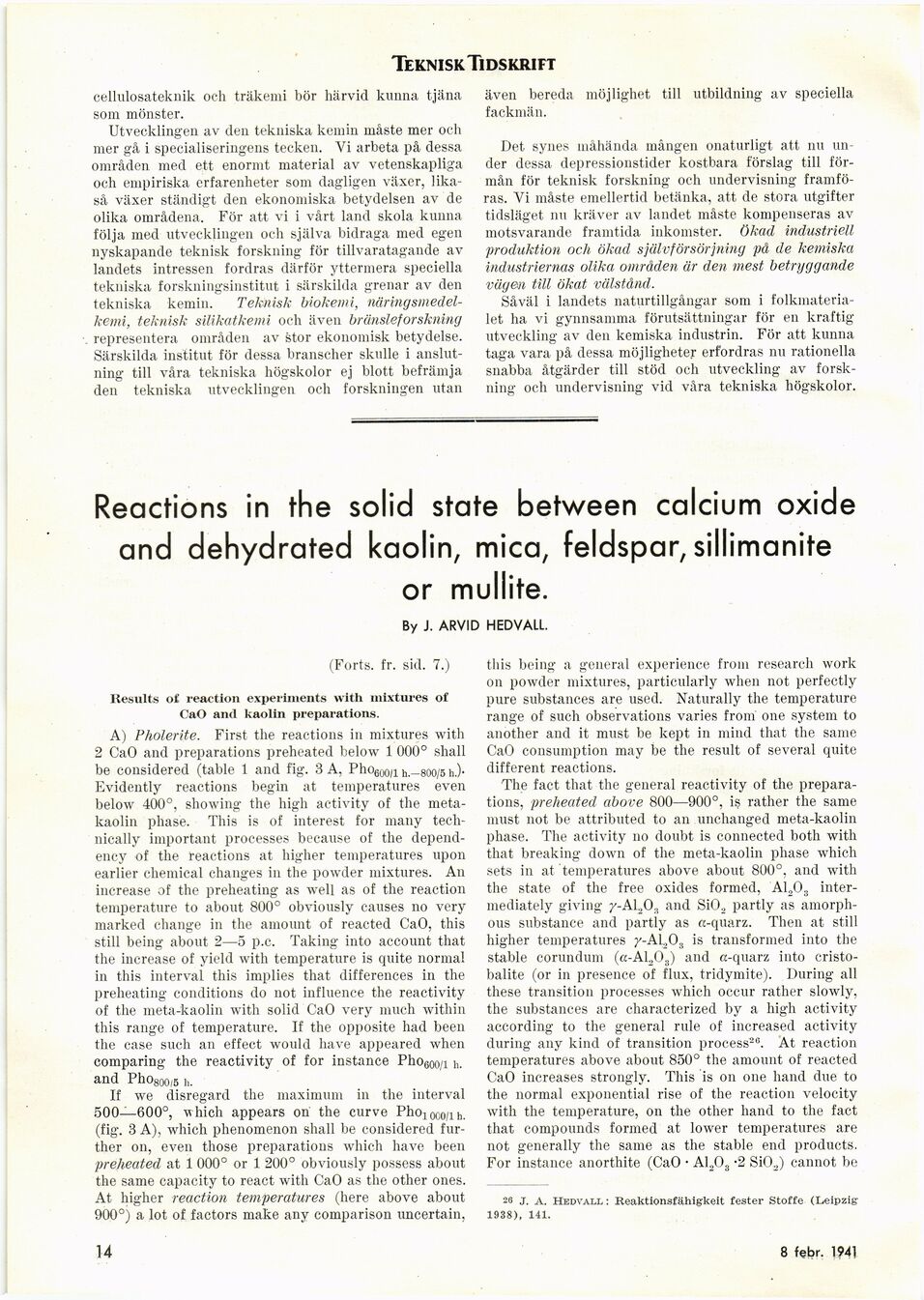
Full resolution (JPEG) - On this page / på denna sida - Sidor ...

<< prev. page << föreg. sida << >> nästa sida >> next page >>
Below is the raw OCR text
from the above scanned image.
Do you see an error? Proofread the page now!
Här nedan syns maskintolkade texten från faksimilbilden ovan.
Ser du något fel? Korrekturläs sidan nu!
This page has never been proofread. / Denna sida har aldrig korrekturlästs.
Teknisk Tidskrift
cellulosateknik och träkemi bör härvid kunna tjäna
som mönster.
Utvecklingen av den tekniska kemin måste mer och
mer gå i specialiseringens tecken. Vi arbeta på dessa
områden med ett enormt material av vetenskapliga
och empiriska erfarenheter som dagligen växer,
likaså växer ständigt den ekonomiska betydelsen av de
olika områdena. För att vi i vårt land skola kunna
följa med utvecklingen och själva bidraga med egen
nyskapande teknisk forskning för tillvaratagande av
landets intressen fordras därför yttermera speciella
tekniska forskningsinstitut i särskilda grenar av den
tekniska kemin. Teknisk biokemi,
näringsmedelkemi, teknisk silikatkemi och även bränsleforskning
representera områden av stor ekonomisk betydelse.
Särskilda institut för dessa branscher skulle i
anslutning till våra tekniska högskolor ej blott befrämja
den tekniska utvecklingen och forskningen utan
även bereda möjlighet till utbildning av speciella
fackmän.
Det synes måhända mången onaturligt att nu
under dessa depressionstider kostbara förslag till
förmån för teknisk forskning och undervisning
framföras. Yi måste emellertid betänka, att de stora utgifter
tidsläget nu kräver av landet måste kompenseras av
motsvarande framtida inkomster, ökad industriell
produktion och ökad självförsörjning på de kemiska
industriernas olika områden är den mest betryggande
vägen till ökat välstånd.
Såväl i landets naturtillgångar som i
folkmaterialet ha vi gynnsamma förutsättningar för en kraftig
utveckling av den kemiska industrin. För att kunna
taga vara på dessa möjligheter erfordras nu rationella
snabba åtgärder till stöd och utveckling av
forskning och undervisning vid våra tekniska högskolor.
Reactions in the solid state between calcium oxide
and dehydrated kaolin, mica, feldspar, si llimanite
or mu llite.
By J. ARVID HEDVALL.
(Forts. fr. sid. 7.)
Results of reaction experiments with mixtures of
CaO and kaolin preparations.
A) Pholerite. First the reactions in mixtures with
2 CaO and preparations preheated below 1 000° shall
be considered (table 1 and fig. 3 A, Pho600/1 soo/5
h.)-Evidently reactions begin at temperatures even
below 400°, showing the high activity of the
meta-kaolin phase. This is of interest for many
tech-nically important processes because of the
depend-ency of the reactions at higher temperatures upon
earlier chemical changes in the powder mixtures. An
increase of the preheating as well as of the reaction
temperature to about 800° obviously causes no very
marked change in the amount of reacted CaO, this
still being about 2—5 p.c. Taking into account that
the increase of yield with temperature is quite normal
in this interval this implies that differences in the
preheating conditions do not influence the reactivity
of the meta-kaolin with solid CaO very much within
this range of temperature. lf the opposite had been
the case such an effect would have appeared when
comparing the reactivity of for instance Pho600/i h.
and Pho8oo,5 h.
lf we disregard the maximum in the interval
500—600°, -which appears ön the curve Pho1000/lh
(fig. 3 A), which phenomenon shall be considered
fur-ther ön, even those preparations which have been
preheated at 1 000° or 1 200° obviously possess about
the same capacity to react with CaO as the other ones.
At higher reaction temperatures (here above about
900°) a lot of factors make any comparison uncertain,
this being a general experience from research work
ön powder mixtures, particularly when not perfectly
puré substances are used. Naturally the temperature
range of such observations varies froni one system to
another and it must be kept in mind that the same
CaO consumption may be the result of several quite
different reactions.
The fact that the general reactivity of the
preparations, preheated above 800—900°, is rather the same
must not be attributed to an unchanged meta-kaolin
phase. The activity no doubt is connected both with
that breaking down of the meta-kaolin phase which
sets in at temperatures above about 800°, and with
the state of the free oxides formed, A1203
inter-mediately giving /-AL,0:) and Si02 partly as
amorph-ous substance and partly as «-quarz. Then at still
higher temperatures ^-AL.Oj is transformed into the
ståhle corundum (a-Al203) and a-quarz into
cristo-balite (or in presence of flux, tridymite). During all
these transition processes which occur rather slowly,
the substances are characterized by a high activity
according to the general rule of increased activity
during any kind of transition process20. At reaction
temperatures above about 850° the amount of reacted
CaO increases strongly. This is ön one hand due to
the normal exponential rise of the reaction velocity
with the temperature, ön the other hand to the fact
that compounds formed at lower temperatures are
not generally the same as the stable end products.
For instance anorthite (CaO • A1203 -2 SiOa) cannot be
26 j. a. Hedvall: Reaktionsfähigkeit fester Stoffe (Leipzig
1938), 141.
14
12 april 1941
<< prev. page << föreg. sida << >> nästa sida >> next page >>